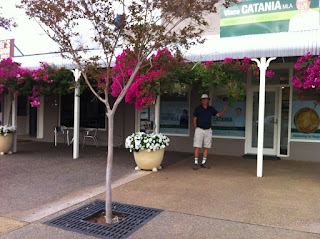An early start to the day and as John had packed away everything last night we departed very quickly. The mornings now seem to be a lot cooler but as the morning progresses the sun begins to warm us. We had to retrace our journey from the Cape down to the North West Coastal Highway. This part of the journey would have to be the most boring of any of our journeys to travel from one place to the next.
We had planned to spend a night at Coral Bay, a small holiday village some 80kms South of Exmouth however there were no vacancies at the park. Any wonder, the place was beautiful with holiday makers very busy enjoying the beaches and driving motorised buggies around the coastal dunes. We called in to the boat ramp area and ver very impressed with how the bay had been developed for launching boats. The water looked so inviting and there were many boats out enjoying some fishing.
Around lunchtime we stopped at a roadside stop on the Lyndon River (which was almost completely dry) near Minilya before continuing on to Carnarvon. The drive became more interesting as we neared Carnarvon. We began to see very large Banana Plantations, Vineyards and Vegetable and Fruit crops which are all flourishing in the deep red soil and water from the Gascoyne River. Carnarvon produces over 30,000 tonnes of fruit and vegetables every year from its 176 plantations.
We had planned to spend a night at Coral Bay, a small holiday village some 80kms South of Exmouth however there were no vacancies at the park. Any wonder, the place was beautiful with holiday makers very busy enjoying the beaches and driving motorised buggies around the coastal dunes. We called in to the boat ramp area and ver very impressed with how the bay had been developed for launching boats. The water looked so inviting and there were many boats out enjoying some fishing.
Around lunchtime we stopped at a roadside stop on the Lyndon River (which was almost completely dry) near Minilya before continuing on to Carnarvon. The drive became more interesting as we neared Carnarvon. We began to see very large Banana Plantations, Vineyards and Vegetable and Fruit crops which are all flourishing in the deep red soil and water from the Gascoyne River. Carnarvon produces over 30,000 tonnes of fruit and vegetables every year from its 176 plantations.
We settled into our site at The Big 4 Plantation Caravan Park then drove a short distance into the township. A small shopping centre appears to have all that the residents need but generally the town looks a bit tired in places.
We drove down to the small Boat Harbour and saw a number of very large fishing trawlers in the harbour. They are Prawn, Snapper and Crab boats and judging from their number, there must be good fishing in the ocean around Carnarvon. We stopped off at a fresh seafood outlet and bought 1 kilo of prawns that we had to wait whilst they were being cooked. You can’t get much fresher than that. It is so interesting that the water here is a much deeper blue not the turquoise/azure blue we have been seeing further up the coast.
We drove down to the small Boat Harbour and saw a number of very large fishing trawlers in the harbour. They are Prawn, Snapper and Crab boats and judging from their number, there must be good fishing in the ocean around Carnarvon. We stopped off at a fresh seafood outlet and bought 1 kilo of prawns that we had to wait whilst they were being cooked. You can’t get much fresher than that. It is so interesting that the water here is a much deeper blue not the turquoise/azure blue we have been seeing further up the coast.
Back at camp, we had an entree of the fresh prawns before John cooked a barbecue at the camp kitchen tonight.
 |
| The grey nomads are still smiling, no wonder, Coral Bay was beautiful. |
 |
| The boat harbour - you can see the Ningaloo reef in the distance. |
 |
| The launching ramp at Coral bay |
 |
| Carnarvon township was very neat and tidy. |
 |
| Some bougainvillaeas were stunning. |
 |
| One of the many prawn trawlers at the jetty. |
No comments:
Post a Comment